Home » Literature Archives » DALI'S CHRISTUS HYPERCUBUS: a case of desacralization
DALI'S CHRISTUS HYPERCUBUS: a case of desacralization
By Ming Zhen Shakya
--Patterns in Comparative Religion, Mircea Eliade
To the person who has had a spiritual experience, mystery and certitude coexist in undisturbed contentment. To him, mystery allows no curiosity and certitude admits no doubts. By definition, his ego was absent during the experience, and he is, therefore, bereft of any judgmental faculty. He knows that he has had a spiritual experience. He can remember it in stunning detail. No one can persuade him otherwise or eradicate even the smallest fact of it.
Particularly if the experience was visionary, an analysis of the epiphany - of its parts, its setting, its characters and the actions they performed, is likewise beneath his consideration. He can report the experience or depict it artistically, but he is neither able nor desirous of explaining it. The occurrence of the event is far more significant than any message it conveyed. It is rather like a singing horse. It is not how well it sings, but that it sings at all.
To the person who has never had a spiritual experience, it is another matter entirely. Although he, too, cannot understand the phenomenon, he does not hesitate to judge it in all its aspects. If his religious views are consonant with the reported vision, regardless of whether he is an intelligent believer or a gullible oaf, he is inclined to accept the epiphany as genuine. If he is an atheist or a member of a competitive religion he is likely to assert that the person who reported such an occurrence is insane, deluded, or deliberately lying,
Sometimes, a spiritually inexperienced person does not concern himself with either the medium or the message. His interest is academic. He judges the literary merit, the painter's technique, or an element in the work, isolating it for special attention. Persons who are spiritually experienced usually refrain from such academic judgments since these secular intrusions tend to initiate a process of desacralization which inevitably converts the sublime to the pedestrian.
The desacralization of a spiritual work has two unfortunate results. The reason that spiritual events usually occur when we least expect them is simply that the ego must be caught off guard. Sometimes this occurs when we are in deep sleep; or when when our attention is distracted while we are performing a routine task; or perhaps when our ego is overwhelmed as when we are rapt, hearing or seeing something of extraordinary beauty.
Only an adept can plan to transcend his ego, to order his awareness to do an end-run around it and cross freely into meditation. For the rest of us, the eclipse of the ego usually comes as a surprise. It must be noted that the attempt to enter meditation via hypnosis is counter-productive. However reliably a person can enter a self-hypnotic state, he has not achieved the transcendental shift from the material world to the world of the spirit. Meditation - the first stage of transcendental experience - is not hypnosis.
When a work of art is desacralized it loses the spontaneity of discovery, the unexpected beauty that assails us when our egoistic awareness and all its judgmental aggressions are snoozing or occupied elsewhere. People who might have experienced the shock and awe of spectacular beauty are literally robbed of it by having been exposed to mundane discussions about choice of phrase, composition, color, perspective, and so on.
The second unfortunate result is that excerpts may become contextually compromised; or repeated reproductions of an artwork may blur its lines or distort its color. This popularity may cause the original to increase in its monetary value but diminish it in its artistic impact. Desacralization may not breed contempt, but the familiarity it provides virtually tends to banality.
A case in point is the extraordinary painting by Salvatore Dali, Corpus Hypercubus ou Crucifixion better known now as Christus Hypercubus.
In the mid-1950s, not knowing even of the painting's existence, I had gone to the Metropolitan Museum of Art to spend a few hours prowling the aisles; and as I passed the time and the masterpieces, I became part of one of those little groups of women who, as Eliot put it, "come and go, talking of Michelangelo."
We turned a corner and there it was. We - all of us - stopped talking and approached the picture. Like a chorus on cue, we sucked-in air and gaped. None of us, fortunately, knew anything about art.
It is a large painting, and as we looked up at it, our eyes were at the level of the emerald green robe of the woman who stands before the suspended figure of Christ, looking up at him exactly as we were.
The cross was not the usual pair of flat brown perpendicular beams, but was rather like a three dimensional golden sun, which, judging from the shadow it cast on the black and white chequered floor, was positioned directly under another unseen sun. The golden body of Christ, however, did not cast a shadow on the floor. So that while the painting was called 'corpus' there could not have been a substantial body present.
His hands and feet had not been pierced by nails. Indeed, he was not attached to the sun cross anywhere: he simply floated in space before it. There were no marks of torture on his body, no labial wound, no blood. His head with its blonde hair bobbed just below the ear, wore no crown of thorns. There was a suggestion of movement. The figure of Christ was not straightforwardly aligned with the sun cross. It seemed to be rotating counter-clockwise, the direction his face was turned. We were seeing that moment in time that was the reverse of the Nativity. Where spirit had once become flesh, flesh was now returning to spirit.
Beyond the chequered floor was the faint outline of a body of water and beyond that a shore and a hilly landscape. A tiny breach in the horizon let the rising sun peep through.
But it was the figure of the devoted woman standing in the foreground that captivated me. I figured that if Christ had been represented as the sun, she had to represent the verdant and devoted earth.
She was wearing what appeared to be an emerald green Douppioni (stiff and shiny) silk robe, its folds bearing the sheen of a light source behind her. This garment was painted so realistically that I actually wanted to reach out and touch the silk. To this day, more than half a century later, I have not seen a realistic depiction of anything that rivaled that green robe.
What green robe?
We search the internet, looking for it.
An article about hypercubes gives us a beige robe and a green and white chequered floor. Christ and the Cross are on the pinkish side.
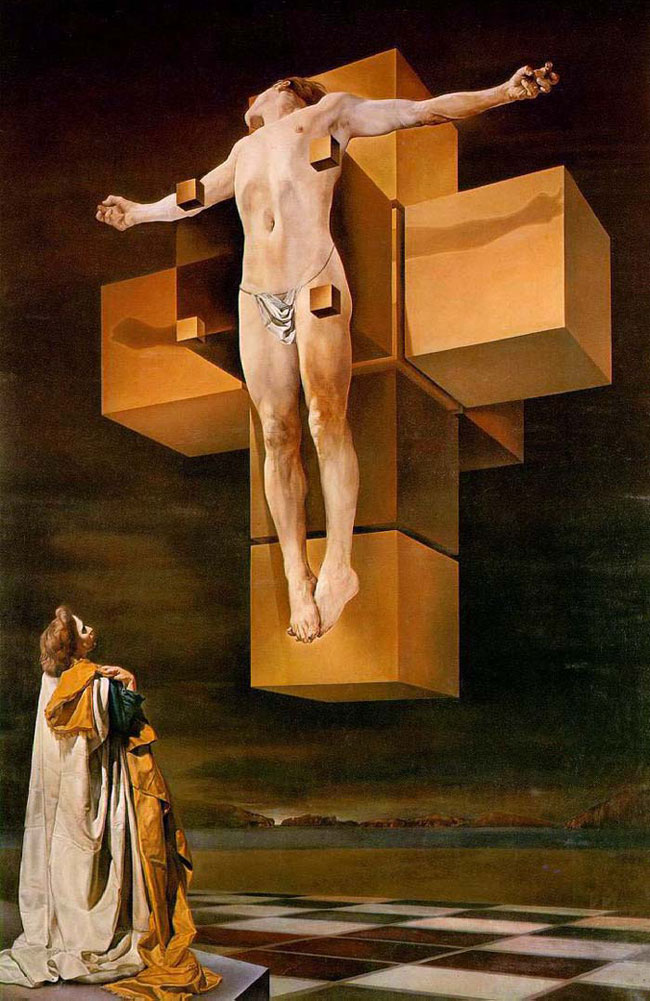
A french website about magic squares or something gives us a greenish Christ and a green and white chequered floor and muddy water behind the floor. But the robe is white with yellowish sheen and greenish dark folds.
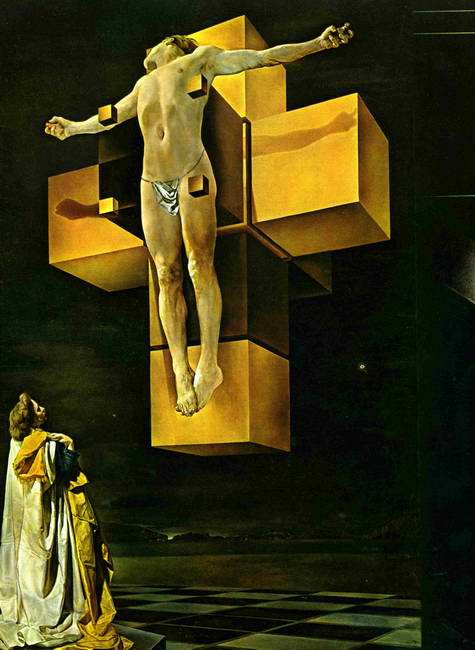
A site that offers hand-signed limited edition lithographs gives the painting a kind of circus coloration. Here the robe is definitely white. Would Dali have signed this? Really?
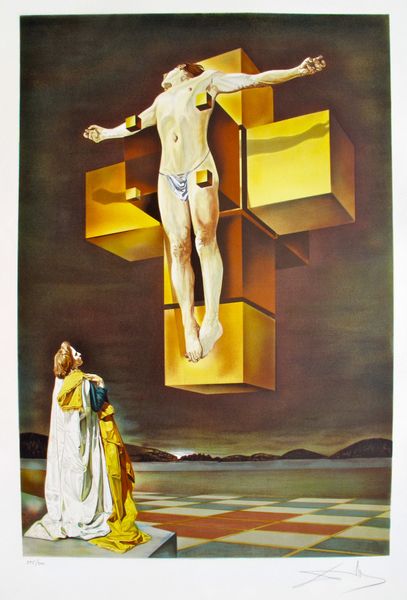
If the above version is too colorful to suit one's taste, an article about Ayn Rand's devotion to the work (because it represented "man-worship - the presentation of an ideal") offers a paler version. Evidently Ms. Rand spent hours at the Met contemplating the picture... the real one... not the one that accompanies the article... which has a grey robe, a bleached out Christ and Cross, a blue shore in the distance and a kind of bluish green chequered floor.
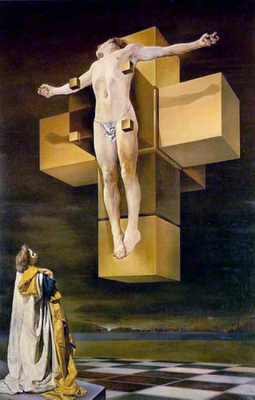
And if this is too large a picture to grasp while attempting to visualize a hypercube, Ohio State's Mathematics department, offers this postage stamp version as an example of the construct being examined in the web's instructions.

In YouTube, there are several Christus Hypercubus videos having numerous Christuses Hypercubuses flying slowly through the air. Anyone can be forgiven if he recalls the dozen or so men dressed like Elvis Presley sky-diving together... these were the Flying Elvii or Flying Elvoi, depending on your (not my) knowledge of Latin and Greek plurals.
In a Flickr presentation by Wallyg (probably the closest reproduction of the painting we can find), we see an actual photograph of the painting as it is hung in the Met. We are told:
Dalí's Crucifixion (Corpus Hypercubus) depicts a crucified Jesus Christ upon the net of a hypercube. Dalí's wife, Gala, is the figure in the bottom left looking up at Jesus. The scene is depicted in front of the Bay of Port Lligat. Dalí called his work, Ayn Rand's favorite painting, a "metaphysical, transcendent cubism" based on the Treatise on Cubic Form by Juan de Herrera, Philip II's achitect and builder of the Escorial Palace. The cross is formed by an octahedral hypercube. The number nine is identifiable and becomes consubstantial with the body of Christ.
The robe is more green here, but to achieve its color, the painting has been darkened a tad as we can tell by the gray wall behind it. No doubt I am missing something here, but the number 9 does not jump out at me. And if "crucify" means to be nailed or tied to a cross, then this Christ is not crucified. He is floating with his arms outstretched.
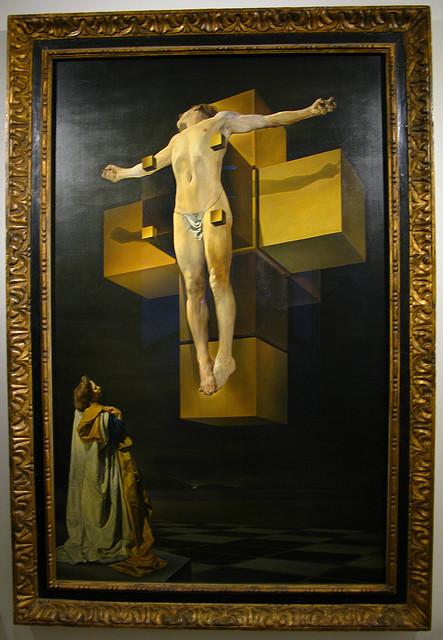
I know to a certainty that in the mid 1950's the woman in the painting was wearing an emerald green, probably Douppioni silk, robe. No one can tell me that I am mistaken. That is what a transcendental moment means. Certitude. It is certitude for a Muslim, a Jew, a Christian, or a Buddhist. I would sooner believe that that the painting was somehow damaged or that my Mac has suddenly lost its ability to reproduce colors accurately. We have four Apple computers in this house and every one reproduces the images as given above.
Perhaps the images I have copied were not made with Macs. (Uh, oh... time to talk to the Dark Lord of Seattle.)
Ah, well, we have seen what can happen to the sacred when it exploited by the intellectually inclined.
I hope that the painting is still at the Met. (Sometimes they lend these great paintings out for exhibits elsewhere.) I can only hope that if you find yourself in that other Big Apple you stop in at the Met and see this amazing painting for yourself. Don't be prepared for it. Don't expect anything. Purge from your mind's house all these bastardized offspring of the paternal original. Forget that you ever heard the words "tesseract" and "hypercube" and see only that Christ is turning into spirit again and from that great Cosmic Consciousness he will one day emerge as the Future Messiah, or the Future Mahdi, or, for us Mahayana Buddhists, as the Future Buddha, our Mithras, Maitreya, or Miroku.

